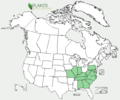Berberis canadensis
Berberis canadensis, commonly known as American barberry or Canadian barberry, is a species of plant in the Berberidaceae family. It is native to the eastern United States and is particularly prevalent in the Appalachian Mountains.
Description[edit]
Berberis canadensis is a deciduous shrub that typically grows to a height of 1–2 meters. The leaves are arranged in clusters, each leaf being 2–5 cm long. The flowers are yellow, 3–6 mm in diameter, and bloom in late spring. The fruit is a red berry, 5–10 mm in diameter, which ripens in late summer or early fall.
Distribution and habitat[edit]
Berberis canadensis is found in the eastern United States, particularly in the Appalachian Mountains. It grows in a variety of habitats, including forests, grasslands, and wetlands. It prefers well-drained, acidic soils and can tolerate both full sun and partial shade.
Uses[edit]
The berries of Berberis canadensis have been used by Native Americans for medicinal purposes. They contain berberine, a compound with antimicrobial, anti-inflammatory, and antioxidant properties. The plant has also been used in traditional Chinese medicine.
Conservation status[edit]
Berberis canadensis is considered endangered in several states in the United States due to habitat loss and overharvesting. Conservation efforts are underway to protect and restore populations of this species.
See also[edit]
![]()
This flora-related article is a stub. You can help WikiMD by expanding it.
-
Berberis canadiensis RB
-
B. canadensis
-
Berberis canadensis
Ad. Transform your life with W8MD's Budget GLP-1 injections from $75


W8MD offers a medical weight loss program to lose weight in Philadelphia. Our physician-supervised medical weight loss provides:
- Weight loss injections in NYC (generic and brand names):
- Zepbound / Mounjaro, Wegovy / Ozempic, Saxenda
- Most insurances accepted or discounted self-pay rates. We will obtain insurance prior authorizations if needed.
- Generic GLP1 weight loss injections from $75 for the starting dose.
- Also offer prescription weight loss medications including Phentermine, Qsymia, Diethylpropion, Contrave etc.
NYC weight loss doctor appointmentsNYC weight loss doctor appointments
Start your NYC weight loss journey today at our NYC medical weight loss and Philadelphia medical weight loss clinics.
- Call 718-946-5500 to lose weight in NYC or for medical weight loss in Philadelphia 215-676-2334.
- Tags:NYC medical weight loss, Philadelphia lose weight Zepbound NYC, Budget GLP1 weight loss injections, Wegovy Philadelphia, Wegovy NYC, Philadelphia medical weight loss, Brookly weight loss and Wegovy NYC
|
WikiMD's Wellness Encyclopedia |
| Let Food Be Thy Medicine Medicine Thy Food - Hippocrates |
Medical Disclaimer: WikiMD is not a substitute for professional medical advice. The information on WikiMD is provided as an information resource only, may be incorrect, outdated or misleading, and is not to be used or relied on for any diagnostic or treatment purposes. Please consult your health care provider before making any healthcare decisions or for guidance about a specific medical condition. WikiMD expressly disclaims responsibility, and shall have no liability, for any damages, loss, injury, or liability whatsoever suffered as a result of your reliance on the information contained in this site. By visiting this site you agree to the foregoing terms and conditions, which may from time to time be changed or supplemented by WikiMD. If you do not agree to the foregoing terms and conditions, you should not enter or use this site. See full disclaimer.
Credits:Most images are courtesy of Wikimedia commons, and templates, categories Wikipedia, licensed under CC BY SA or similar.
Translate this page: - East Asian
中文,
日本,
한국어,
South Asian
हिन्दी,
தமிழ்,
తెలుగు,
Urdu,
ಕನ್ನಡ,
Southeast Asian
Indonesian,
Vietnamese,
Thai,
မြန်မာဘာသာ,
বাংলা
European
español,
Deutsch,
français,
Greek,
português do Brasil,
polski,
română,
русский,
Nederlands,
norsk,
svenska,
suomi,
Italian
Middle Eastern & African
عربى,
Turkish,
Persian,
Hebrew,
Afrikaans,
isiZulu,
Kiswahili,
Other
Bulgarian,
Hungarian,
Czech,
Swedish,
മലയാളം,
मराठी,
ਪੰਜਾਬੀ,
ગુજરાતી,
Portuguese,
Ukrainian



